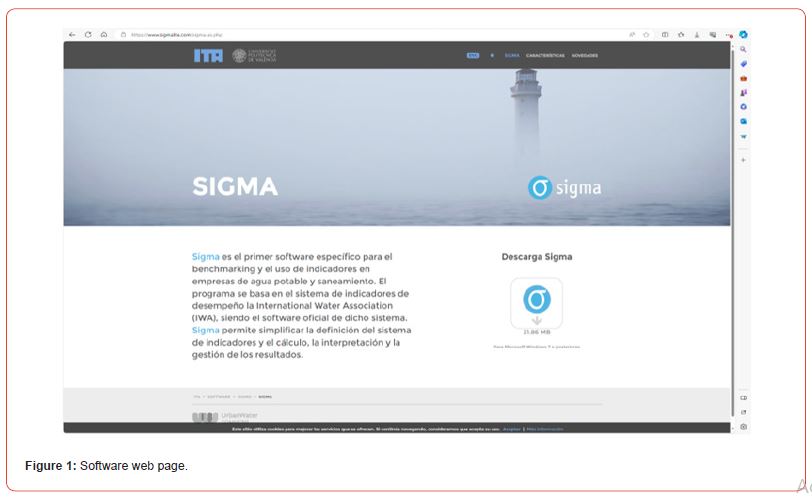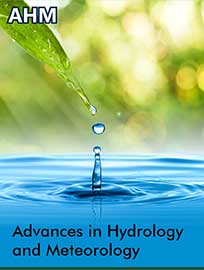 Mini Review
Mini Review
Integrated Urban Water Management: Definition, Indicators and Sigma Lite Programme
Natalia Alegría1*, Igor Peñalva1, Charles Pinto2 and María Urrestizala1
1Energy Engineering Department, Bilbao School of Engineering, University of the Basque Country, Spain
2Department of Mechanical Engineering, Bilbao School of Engineering, University of the Basque Country, Spain
Natalia Alegría, Energy Engineering Department, Bilbao School of Engineering, University of the Basque Country, Spain
Received Date: February 06, 2024; Published Date: February 12, 2024
Introduction
Both water supply and wastewater treatment are two relevant issues of which society is aware. Together with water reuse, they could be considered as the urban water cycle in the case of the cities. Therefore, nowadays Integrated Urban Water Management is a very important process for our society, as it involves the supply, reuse and treatment of water before it is incorporated back into the water cycle.
Since many countries and regions have not yet defined an integrated urban water management system, this paper will define what integrated water management involves and how it can be achieved by studying the management indicators defined by the IWA (International Water Association). Finally, the Sigma Lite software, a fundamental tool for evaluating these indicators, will be explained.
Definition of Integrated Urban Water Management
Among the existing definitions of Integrated Urban Water Management (IUWM), the following can be highlighted: “Integrated Urban Water Management is a flexible, participatory and iterative process that integrates the elements of the urban water cycle (water supply, sanitation, stormwater management, and waste management) with urban city development and river basin management to maximise economic, social and environmental benefits in an equitable manner”, defined and adopted by the Blue Water Initiative for Green Cities [1].
This management encompasses the complex and complete task of managing the systems or processes that enable urban supply (with water for consumption), reuse (water for non-human uses), as well as the treatment of wastewater (water already used) generated in cities.
Some basic principles required for Integrated Urban Water Management activities have been obtained from the literature review, after evaluating best practices around the world. The following can be highlighted [2]:
-It must be adapted to the specific and dynamic challenges of each urban area. Integrated Urban Water Management approaches can vary considerably depending on the institutional arrangements for urban water management in a particular urban area, as well as the specific water challenges.
-It should involve various instruments and participatory approaches to help key institutional and non-institutional partners to develop an agreed diagnosis of the challenges of the urban area, as well as a shared vision of future development in the urban area of influence.
-It should not be a single, individual or one-off action, but a long-term iterative process. The characteristics and challenges of urban areas are bound to change over time. This is why Planning becomes a cyclical process that continuously reviews the challenges and priorities of urban areas, as well as the measures and actions to address these challenges.
-It must involve institutions and processes as well as infrastructure and investments. Integrated water management in an urban setting tends to be challenging as it involves a wide range of systems and institutions, both within the city and at the river basin level.
-It must be informed by solid science and technical analysis. Although Integrated Urban Water Management is quite a political issue, stakeholder decision-making must be based on good technical analysis.
-It must require moving away from segmented and linear thinking to a more holistic approach. A key objective of Integrated Urban Water Management is to move from a linear approach to water problems-which relies on unlimited resource availability and cannot cope with adverse impacts of waste and other outcomes on the environment and society-to a cyclical metabolism that aims to avoid, minimise and transform inputs in the city in order to reduce or eliminate these outcomes, i.e. negative impacts on the quality of life of residents and on the environment [3].
-It must address today’s challenges without losing sight of the future.
Throughout the integral cycle, it is necessary to take into account the technical and commercial management aspects, tariff system, customer service, analysis of indicators and data, and development of standards and technical regulations. A fundamental aspect of this cycle is the customer service, which seeks to ensure customer proximity and comfort, agility and immediacy of the procedures, and complete and transparent information.
As the management of the integral water cycle is a complex activity, it is necessary to combine multidisciplinarity (of actions, tasks, works and techniques). Among others: hydraulic technology, physico-chemical and biological processes, sanitary and environmental engineering techniques, quality control laboratories, industrial maintenance, communications and remote control, computer and automatic techniques (complex databases), commercial relations with clients, security, tariff structuring and management, business management (economic/ financial). Moreover, as it has high social impact (water is a basic and vital good and, in Spain, a scarce resource), it entails health, hygiene and sanitation, productive and industrial processes, basic environmental resource, management of non-conventional resources, political and legal.
There are many infrastructures and services required to meet the demands of citizens and society, including: dams, weirs, intakes, canals, pipes, impulsions, aqueducts, drinking water treatment plants, desalination plants, storage tanks, distribution pipe networks, connections, individual metering meters, wastewater pumping, scuppers, drains, sewage networks, collectors, outfalls, sewage treatment plants, lamination or storm tanks, drying plants, drying plants, sewage treatment plants, sewage treatment plants, sewage treatment plants, sewage treatment plants, sewage treatment plants, sewage treatment plants, sewage treatment plants, sewage treatment plants, collectors, outfalls, sewage treatment plants, wastewater treatment plants, lamination or storm tanks, sludge drying, incineration or composting plants and production of biosolids, plants for the regeneration of previously treated water, pipes for transporting reusable water, among others.
Management Indicators
Management Indicators (MI) are used in many industrial sectors as a tool and their potential in the water industry is unquestionable. Many members of the IWA [4], consider that the Association should define guidelines on the indicators to be adopted in the field of water supply and the information that should be collected in order to evaluate them.
In this context, a good management system needs the incorporation of six groups of indicators: water resources, personnel, physical, operational, service quality and financial (see Table 1):
Table 1: Proposal for Managements Indicators (MI).

A management indicator is a quantitative measure of a particular aspect of the performance of the supply or service model. It assists in the monitoring and evaluation of the efficiency and effectiveness of the supply, thus simplifying a normally complex assessment. The term efficiency refers to the degree to which the resources of a supply are used optimally to provide service. On the other hand, the term Effectiveness refers to the degree to which stated objectives (are achieved realistically and specifically defined).
As the implementation of the complete system might be too demanding for many supply companies, 3 levels of MI are considered as a guideline for the definition priorities, according to their importance as a management tool. For the others, however, a stepby- step implementation would be recommended. The complete set incorporates 133 indicators, of which 26 are considered top priority by the IWA.
As a guide for the definition of priorities, a fourth level is considered in addition to the usual three levels of MI, according to the importance as a management tool:
-Level 1, known as L1: a first layer of indicators that provides a management overview of the efficiency and effectiveness of the supply company.
-Level 2, known as L2: additional indicators, which provide a better insight than Level 1 indicators for users with a greater need for detail.
-Level 3, known as L3: indicators that provide the greatest amount of detail, but are still relevant for the highest level of management.
-Complementary Level: complementary indicators that provide a greater amount of detail than Level 3 indicators or that are for specific use at departmental level (which is often supplydependent).
Indicators that conceptually have a certain level of importance, but cannot be reliably assessed are classified at a lower level. Table 2 shows the proposed Management Indicators.
Table 2: Proposed Management Indicators (MI).

The variables required to obtain the management indicators have the following objectives:
-To enable a comprehensive interpretation of the concepts described in the text.
-To serve as a guide for the creation of an information system for the evaluation of management indicators.
-To assist in carrying out audits.
It is recommended that companies carrying out integrated water management, which are willing to adopt the IWA management indicators, should make personalised records of the different variables, and it is highly recommended that they adopt the same date for all the variables that require a reference date.
It is highly advisable that target confidence levels specified in terms of reliability and accuracy are defined for each input variable.
In addition, a scheme of confidence levels is necessary so that users of performance indicators and context information are aware of the reliability of the information available. This aspect has been developed in England and Wales and there is no evidence at this point that it is not appropriate for other countries [5]. Confidence levels should provide a rational basis for companies to rate the information provided by audits in terms of reliability and accuracy. It is essential that companies and their auditors give proper attention and a high level of amplification to the assignment of data confidence levels.
Sigma Lite software

Several softwares have been developed as a tool for the calculation of MI, but the one with the best results is the Sigma Lite software [6], which is the first specific software for benchmarking and the use of indicators in water and wastewater utilities (see Figure 1). The programme is based on the system of indicators defined by the “International Water Association (IWA)”, being this software the official tool of this system. With Sigma Lite, the definition of the indicator system and the calculation, interpretation and management of the results can be simplified. This software makes it possible to create and/or improve the indicators already defined.
Conclusion
After this study, it can be concluded that Integrated Water Management is in a process of continuous improvement and for this, the companies or entities that carry it out have a series of Management Indicators that allow them to improve their daily activity, using the indicators defined by the IWA and implemented in the Sigma Lite programme.
Acknowledgement
The authors would like to thank the Water Hall “CABB” (The Bilbao Bizkaia Water Consortium (CABB, in Spanish), a Business Hall located at the Bilbao School of Engineering, where data to make this revision related to energetic generation along the water supply system of Greater Bilbao were available.
Conflict of Interest
No conflict of interest.
References
- Water Overview: Development news, research, data | World Bank.
- An approach to Comprehensive Urban Water Management | iWater.
- Novotny Vladimir (2010) Ecocities: Evaluation and Synthesis. Water Centric Sustainable Communities: Planning, Retrofitting, and Building the Next Urban Environment.
- International Water Association-International Water Association (iwa-network.org).
- File (eureau.org).
- Performance management for water supplies. ITA. Presentation. (sigmalite.com).
-
Natalia Alegría*, Igor Peñalva, Charles Pinto and María Urrestizala. Integrated Urban Water Management: Definition, Indicators and Sigma Lite Programme. Adv in Hydro & Meteorol. 1(4): 2024. AHM.MS.ID.000518.
-
Urban water management; Water cycle; Stormwater management; Urban areas; Environment; Biological processes; Non-conventional resources; Plants; Management indicators
-

This work is licensed under a Creative Commons Attribution-NonCommercial 4.0 International License.






